In the estimation of many, Italy is the true heart of Western gastronomy. France gets so much of the glory, but it wasn't until Catherine de' Medici of Florence married French King Henry II and brought her chefs with her that their cuisine set on the road to such lofty achievements. A major flaw of going one-meal-per-country is that even the most culinarily interesting and diverse countries only show up once. Well, except for Italian food — thanks to the Holy See (aka Vatican City, a permanent observing state) and San Marino (a tiny but full-fledged member), we essentially get three shots at it! (Oh, I guess thanks to Monaco we'll get French food again. Score!) But even then, there's so much variety across Italy owing to a wide diversity of climates and geographies; to name just one important distinction, the North tends to use butter and the South olive oil as the cooking fat of choice.
One great thing about this project is that there's always a theme for a birthday party. Italy marks Laura's third birthday nosh, after Canada and France. In a shocking break with tradition, I'm the one who took the group photo, so Laura's included! Surrounding her are Erin, Lisa, Anna, Alicia, Jessica, Kirsty, Sarah-Doe, and Elsa. Note the utterly empty bowl that once held pesto pasta.
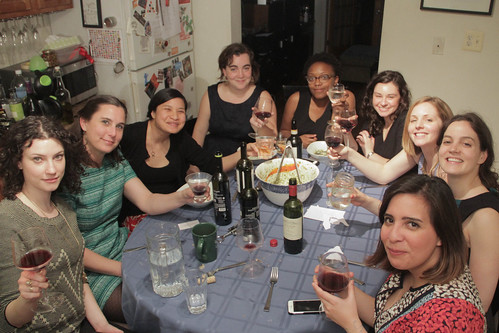
Antipasti | Appetizers
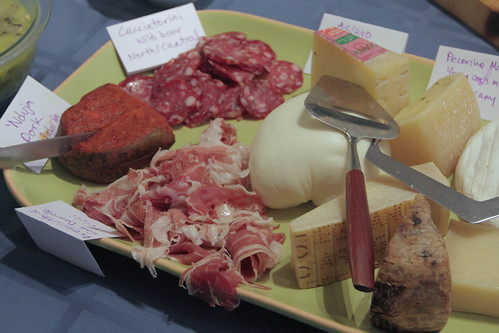
Our pre-dinner entertainment was tarot card readings (tarot was invented in Italy, who knew?), so we needed an appetizer that didn't require formal service. Fortunately, Italian food has perfected the art of pre-dinner nibbling with the antipasto, literally, "before the pasta." The spread gave me the opportunity to represent preserved foods from around the country.
For meats, we had San Daniele prosciutto from Friuli in the northeast, richly spiced cacciatorini salame from throughout the north and central regions, and a spreadable, fiery 'Nduja from Calabria. I can't even remember all the cheeses, but they included a fresh sheep's-milk ricotta from Lazio near Rome, a delicious, medium-flavored snacking cheese called bra from Piedmont, and a truly distinctive cheese called formaggio di fossa, so named because it's buried in a pit and allowed to anaerobically ferment for a few months, making for a really pungent, sharp, and crumbly cheese. I also roasted some eggplant, chopped it up, and doused it with olive oil, garlic, oregano and salt to make a Southern Italian salad-dip-like thing.
Pane tipo Altamura | Semolina sourdough bread | Recipe
(Sorry there's no photo. Imagine a round loaf of bread.)
I was going to make a ciabatta, until I discovered that it was invented in...1982! So I went searching for an older one, and given my love of sourdough and alternative flours, I ended up with this bread from Apulia, which is known in Italy as Puglia. (Why does English mangle it? Some Anglicizations make sense, like Florence for Firenze and Naples for Napoli. But Apulia, as well as Genoa for Genova, don't seem to add anything.)
Since Roman times, the semolina-based loaf from this particular town has received wide acclaim, and I gotta say it turned out great when I made my best imitation. Moderately spongy with medium holes, a substantial but not overwhelming tang, a bit of nuttiness from the semolina and a crispy but not overly-thick crust made this one of the favorites I've ever made. The only downside is how long it takes to make it: 40 minutes, then 2.5 hours, then 2 hours, then a relatively long bake — something that can only be made on a leisurely weekend day. This bread went great with the antipasti, and the second loaf I made held up admirably for several more days.
Aperol spritz
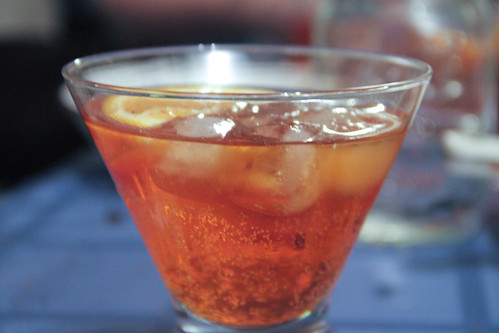
We're not big fans of Negronis and those other classic Italian cocktails, Laura and I find them too bitter. But this, the famous apertivo of Venice, won our vote: three parts prosecco, two parts Aperol, one part soda, with ice and a slice of orange. Aperol is indeed made of some bitter things, but it's milder and sweeter, and when paired with the dry bubbly, it's just lovely and refreshing.
Pasta fresca all'uovo con pesto alla genovese | Fresh pasta with basil pesto | Recipe
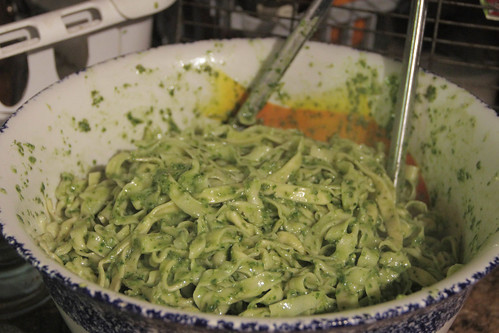
In a proper Italian meal, the primo piatto, the first plate, is generally pasta or soup. Uh, duh, pasta please.
I can't believe I'd never made pasta until now, and it was just as fun and satisfying as folks had told me it would be. With something so simple — it's just flour and eggs — the ingredients are extremely important. I used Italian Tipo 00 flour, which is milled super-fine, which helps it cook faster and also not require as much hydration (hence no added water beyond the moisture from the eggs), leading to a softer texture. The eggs came from the farmer's market. Making up the dough (pasta means paste, as in dough) was easy enough, the laborious part was cranking the sheets of dough through ever-narrower settings on the (borrowed) machine, carefully dusting each layer with flour to avoid them sticking.
Pesto means "pestle," as in the thing you use with a mortar to mash something. Fortunately, the Cuisinart has eliminated the tedium of mashing basil, garlic, grated hard cheese, pine nuts and olive oil with pieces of stone, so this classic Ligurian sauce came together in just a few minutes. Sharp from raw garlic, rich from abundant oil, and fresh and aromatic from basil, the pesto played so well against the soft, mildly eggy canvas of the fresh pasta. There was nary a noodle left after just a few minutes.
Involtini di manzo in salsa di tomate | Beef pinwheels | Recipe

In Northern Italy, meat is traditionally more abundant, and meat dishes are often straightforward hunks of flesh. In the poorer South, meat is treated as more of a luxury good, whose flavor is to be stretched by blending with complementary ingredients. Perhaps an illustration of this distinction is the two meanings of the word braciole: to northerners it'd be medium-thick slices of meat, to southerners it's meat slices pounded thin and stuffed. The latter, which is also universally known in Italy as involtini or "roll-ups," is what we had for a main course. I made it Sicilian-style with breadcrumbs, grated cheese, raisins and pine nuts (ironically, the pine nuts were far more expensive per pound than even the grass-fed beef), held together with a toothpick and browned all sides until cooked through. With the pan juices, I built up a tomato sauce, then put the involtini back in. The great thing about this dish is you can cook ahead of time, and reheat in just a few minutes. (It's also pretty yummy cold!)
Cassata ricetta mia | Sicilian layer cake, my way
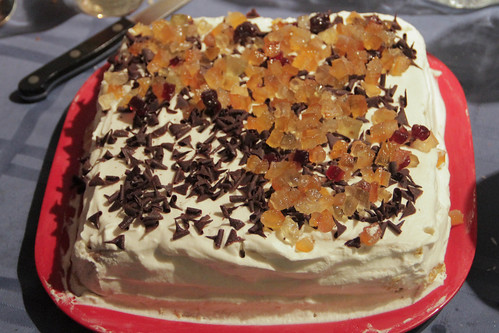
A birthday party needs a cake, right? The cassata, probably Italy's most famous cake, is made with sponge cake soaked in rum, and layered with the same sort of creamy spread you find in cannoli. The recipe I found looked cool because it uses a layer of marzipan lined with chocolate to give the thing body; I half-managed to layer the pan with the rolled-out almond paste, but spreading with molten chocolate was a disaster and it all clumped up. I changed course by mushing it all into a layer of chocolatey marzipan, and used that as a layer of the filling. Another layer was sweetened ricotta cheese studded with chocolate curls. Candied fruit is a traditional part of the cake, but Laura doesn't like it, so I kept a corner clear for her. The cassata was rich and delicious, but be warned that whatever recipe you follow is going to be a whole lot of work.
Gelato di cioccolato | Chocolate gelato | Recipe
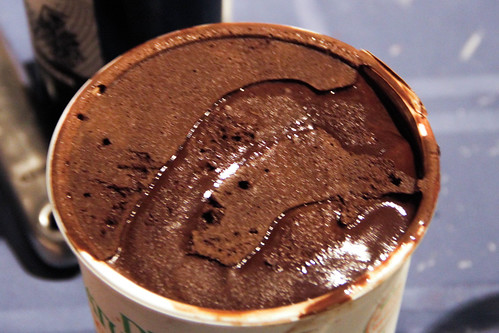
Drop the mic, put a cork in it, closing time, etc. I shall no longer search for a chocolate ice cream recipe, because there's no way anything could be better than this gem, which comes to us by way of the beloved goddess of Italian cuisine, Marcella Hazan.
What's all the more astonishing is that it's so rich and sumptuous, yet as a gelato contains no cream. So why's it so rich and tasty, and smoother than any frozen dessert I've ever made? Surely the blend of rich cocoa powder and melted semisweet chocolate rounds out the flavor, but the trick is in a dash of caramel that you whip up in a pan on the side and pour into the custard right as it firms up.
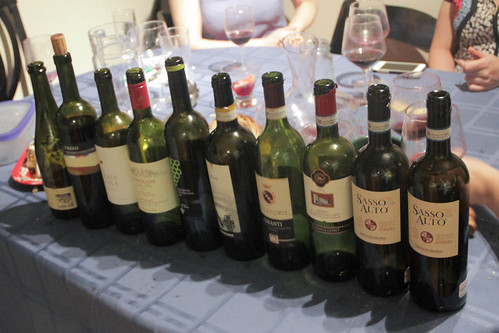
We went through roughly a bottle of Italian wine apiece, plus the Aperol Spritz. The recycling collectors must think we're lushes with very particular regional taste in wine.